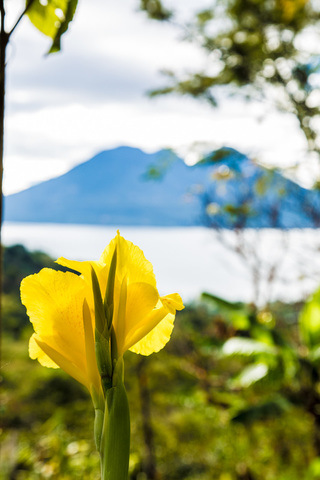Location, Location, Location: On Permaculture and Why It Matters Where You Do Your Yoga Teacher Training.
By: Joanna Cohen
I spent this March in a Kula Collective yoga teacher training at The Yoga Forest in San Marcos, Guatemala. I arrived prepared to learn many things: yoga philosophy, asana, spirituality; maybe even some Spanish.
But when I stepped foot atop the mountain overlooking Lake Atitlan it was clear that this was no ordinary training location. I was about to learn from this majestic forest itself.
Jon, the grounds manager on site, showed me to my tent and told me that The Yoga Forest is a “permaculture” farm. I’d only heard the word permaculture a few times in my life. I had no idea what it meant.
So, what is Permaculture, actually?
I like this very simple definition by Bill Mollison:
Permaculture is a philosophy of working with, rather than against nature… and of looking at plants and animals in all their functions, rather than treating any area as a single product system.
This includes us as human beings: how can we design our day-to-day routines and the places we live as part of this ecosystem of creatures around us, as opposed to above it and taking from it?
Permaculture experts offer specific directions and “design principles” that instruct on how to create life in this way. The Yoga Forest was built from the ground up with these guidelines in mind.
As three weeks at The Yoga Forest passed I learned yogic philosophy from class and yogic life from the forest. Permaculture living came to be one expression of everything we were learning about yoga.
What does this mean practically?
Off the bat there are some apparent applications of permaculture living at The Yoga Forest.
Compost Toilets:
The toilets at TYF are compost toilets. This means that there is no flushing system, adhering to the permaculture principle “create no waste”. Below the toilet sits an amassing (absolutely no pun intended, but now it makes me laugh) pile of poop. When this is mixed with sawdust and ash it decomposes over time and turns to soil that can be reused.
Interesting fact: Pee is what makes the compost toilets smell bad! At TYF you're asked to pee on the grass (and not the toilet) as much as possible. Your squatting game gets very good.
Solar Energy:
Anything that requires power at TYF relies on the sun. This means that all lighting at the forest (including light in all personal rooms/tents), Internet and hot water for showers are dependent on the amount of sunlight “collected” each day. When the sun shines showers are generally warm, Internet works and there is ample light. On cloudy days the opposite is true.
Trash Cans (or lackthereof):
There are very few trash cans on the property, encouraging and accommodating the minimal waste produced at TYF. I found that when there is nowhere to put it, it becomes habitual not to create garbage.
But what about the waste that does crop up, inevitably? TYF creates “plastic bricks” using plastic water bottles and this excess waste. Miscellaneous plastic and garbage is stuffed tightly into the plastic bottles until they're full, and then these hard bottles are used as bricks to build houses and other structures in the community.
Natural Products:
When your products — shampoo, toothpaste, soap and so on — are all natural they can go right back into the earth without harmful effects. This allows us to use an amazing outdoor shower at TYF, to brush our teeth (and spit it out) anywhere on the property and to live harmoniously with our neighbors who live nearby on the land.
And what does this have to do with becoming a yoga teacher?
I didn’t expect permaculture design to enter my life when I arrived at The Yoga Forest. I was there for yoga teacher training, after all. I was even more surprised when permaculture philosophy followed me home to New York City. Many of us are accustomed to fast paced, mass-produced life in big cities. This life barely leaves enough space to fully consider our own needs; it’s extremely daunting to explore our connection to larger systems.
But there’s a bubbling need in cities and around the world to refine. People everywhere are seeking more conscious lifestyles and habits, making changes in everything from the foods they eat to the ways they travel (think: ride sharing). This need to refine in our own lives is the reason we found yoga, isn’t it?
A move towards “working with” our surroundings is underway — a move towards ways of living yoga as opposed to doing yoga. Living at The Yoga Forest during teacher training taught me as much about yoga as classes and texts themselves. Yoga is a lifestyle, and learning to live it is an invaluable aspect of becoming a teacher. As teachers our job is to go out and share this way of life.
So when you choose a yoga teacher training program, ask yourself whether the environment will teach you to live your yoga and make sure the answer is yes.
The Kula Collective hosts trainings around the world at partner sites that support the holistic growth of new yoga teachers. Check out our locations and join us for a teacher training!
About Joanna:
Joanna has spent the last 5 years traveling, working remotely with startups, writing and studying yoga. She has a passion for creating and sharing great products with people she loves. She is an RYT-200 and has completed teacher trainings with CorePower, Sivananda and most recently Kula Collective!




